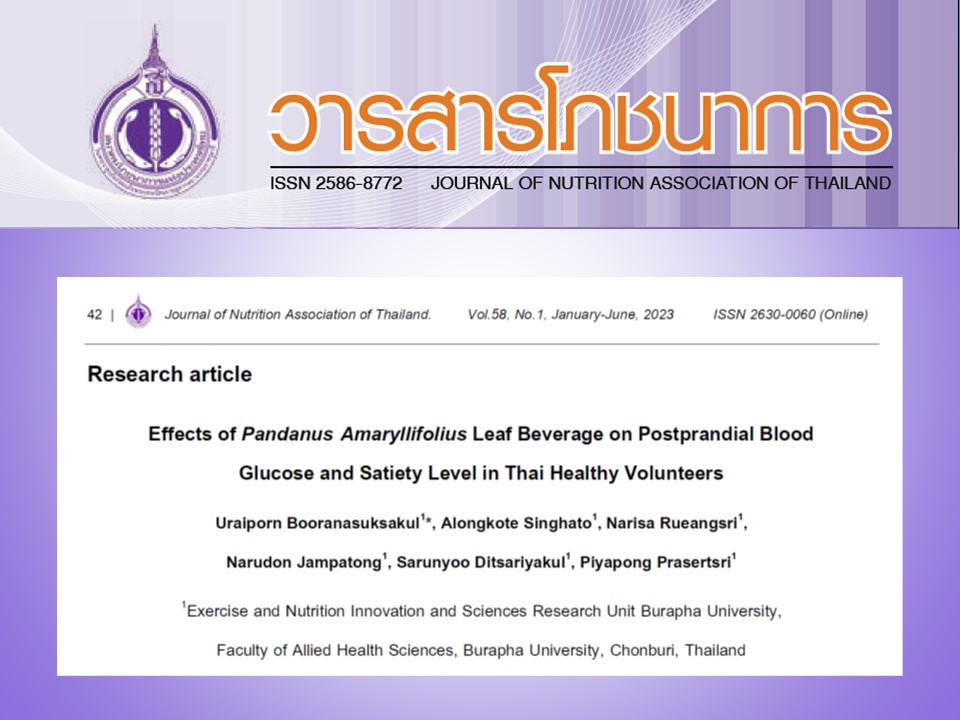Effects of Pandanus Amaryllifolius Leaf Beverage on Postprandial Blood Glucose and Satiety Level in Thai Healthy Volunteers
Keywords:
Pandanus Amaryllifolius, Blood glucose, SatietyAbstract
Pandanus Amaryllifolius (PA) leaf extracts were associated with reducing blood glucose levels in animal models; however, the effects of PA leaf beverages on blood glucose in humans are required to clarify this association. This study evaluated the effect of PA leaf beverage consumption on postprandial blood glucose, satiety level and metabolic responses in Thai healthy volunteers. This was a randomized crossover study. Thirteen healthy volunteers aged between 20 and 23 years old were randomly assigned to consume either glucose solution (25 g of glucose powder in 150 ml of water) or PA beverage (2 g of PA dried leaf powder plus 25 g of glucose powder in 150 ml of water). Blood glucose, satiety, blood pressure, heart rate, and body temperature were measured at baseline (0 minute) and at 30-, 60-, 90-, and 120 minutes after consuming the beverages. Postprandial blood glucose level after consuming PA beverage was 10% significantly higher than those of glucose solution at 90 min (p<0.05). However, the area under the curve (AUC 0-90) of postprandial blood glucose when consumed PA beverage was slightly smaller than when consuming glucose solution (178.50 ± 20.34 and 180.21 ± 16.21, respectively). Moreover, satiety levels at 30, 60, 90, and 120 minutes after consuming PA beverage were higher, but not significant, than when consumed glucose only. There were no differences in blood pressure, heart rate, and body temperature comparing the consumption of the two beverages. This study suggested that a single dose of 2 g of PA with 25 g glucose did not improve blood glucose regulation. There was no statistical difference in satiety score between PA and control group.
References
รายงานสถานการณ์โรค NCDs พ.ศ. 2562 เบาหวาน ความดันโลหิตสูง และปัจจัยเสี่ยงที่เกี่ยวข้อง. กรมควบคุมโรค กองโรคไม่ติดต่อ กระทรวงสาธารณสุข [เข้าถึงเมื่อ 18 เมษายน 2566]. เข้าถึงได้จาก: https://ddc.moph.go.th/uploads/publish/1035820201005073556.pdf
Viengthong P, Bunloet A. Prevalence and Associated Factors of Poor Glycemic Control among Type 2 Diabetes Elderly Patients in a Community Hospital, Khon Kaen Province. Srinagarind Med J 2020; 35(4): 476-483.
Chaiyakul S. Sugar: Health Risks and Policy Actions for Healthier Consumption. J Nutr Assoc Thailand 2020; 55(1):95-110.
Harding JL, Pavkov ME, Magliano DJ, Shaw JE, Gregg EW. Global trends in diabetes complications: a review of current evidence. Diabetologia 2019; 62(1):3-16.
Einarson TR, Acs A, Ludwig C, Panton UH. Economic burden of cardiovascular disease in type 2 diabetes: a systematic review. Value in Health 2018; 21(7):881-90.
Ye L, Xu J, Zhang T, Lin X, Pan X, Zeng W, Ren Y, Shan P. Global burden of noncommunicable diseases attributable to high fasting plasma glucose. J Diabetes 2020; 12(11):807-18.
Reshidan NH, Abd Muid S, Mamikutty N. The effects of Pandanus amaryllifolius (Roxb.) leaf water extracts on fructose-induced metabolic syndrome rat model. BMC Complement Altern Med 2019;19(1):1-3.
Reshidan NH, Abd Muid S, Mamikutty N. The effects of Pandanus amaryllifolius (Roxb.) leaf water extracts on fructose-induced metabolic syndrome rat model. BMC Compl Alternative Med 2019; 19(232):1-13.
Saenthaweesuk S, Naowaboot J, Somparn N. Pandanus amaryllifolius leaf extract increases insulin sensitivity in high-fat diet-induced obese mice. Asian Pac. J. Trop. Biomed 2016; 6(10): 866-71.
Yuningtyas S, Mariam S, Nisa A. Aktivitas antihiperglikemia ekstrak air dan heksana daun pandan wangi (Pandanus amaryllifolius) terhadap tikus putih (Rattus novergicus). Pharmamedika J 2017; 2(2): 70-6.
Quyen, N.T.C.; Quyen, N.T.N.; Nhan, L.T.H.; Toan, T.Q. Antioxidant activity, total phenolics and flavonoids contents of Pandanus amaryllifolius (Roxb.). IOP Conf. Ser. Mater. Sci. Eng 2020, 991, 12019.
Chiabchalard A, Nooron N. Antihyperglycemic effects of Pandanus amaryllifolius Roxb. leaf extract. Pharmacogn. Mag 2015 Jan;11(41):117.
Chen C-YO, Rasmussen H, Kamil A, Du P, Blumberg JB. Orange pomace improves postprandial glycemic responses: an acute, randomized, placebo-controlled, double-blind, crossover trial in overweight men. Nutrients 2017; 9(130): 1-12.
Solah VA, Meng X, Wood S, Gahler RJ, Kerr DA, James AP, et al. Effect of training on the reliability of satiety evaluation and use of trained panellists to determine the satiety effect of dietary fibre: A randomised controlled trial. PLoS One 2015; 10(5):e0126202.
Yongkhamcha B. Chemicals and Antioxidant Activity of Ethanol Leaf Extract from Pandanus amaryllifolius Roxb. Cultivated in Salinity Soil in Ban Donman Village, Maha Sarakham, Thailand. Prog Appl Sci Tech 2020; 10(1): 194-206.
Chaput JP, Tremblay A. The glucostatic theory of appetite control and the risk of obesity and diabetes. Int J Obes 2009; 33(1): 46-53.
Bornet FR, Jardy-Gennetier AE, Jacquet N, Stowell J. Glycaemic response to foods: impact on satiety and long-term weight regulation. Appetite 2007; 49(3): 535-53.
Madden CJ, Morrison SF. Central nervous system circuits that control body temperature. Neurosci. Lett 2019; 696: 225-32.
Wilinski D, Winzeler J, Duren W, Persons JL, Holme KJ, Mosquera J, Khabiri M, Kinchen JM, Freddolino PL, Karnovsky A, Dus M. Rapid metabolic shifts occur during the transition between hunger and satiety in Drosophila melanogaster. Nat. Commun 2019; 1-14.
Manolis AS, Manolis TA. Sugary Beverages Pose Significant Risks to Cardiovascular and Overall Health. Rhythmos 2019; 14(3):45-50.

Downloads
Published
How to Cite
Issue
Section
License
Upon acceptance of an article, copyright is belonging to the Nutrition Association of Thailand.


